The Google Nexus 6P Review
by Andrei Frumusanu on December 16, 2015 8:00 AM ESTSystem & CPU Performance
The Nexus 6P comes with a Snapdragon 810 designed by Qualcomm. This is a big.LITTLE 4x A53 @ 1.55GHz + 4x A57 @ 1.95GHz SoC. As we’ve hopefully come to be very familiar with the chipset over the last couple of months, the key characteristics with which the 6P can differentiate itself from other Snapdragon 810 devices is through software optimizations. In particular the fact that the Nexus 6P comes with Android 6.0 Marshmallow should allow it to be able to showcase some improvements which we’ll dive into a bit later.
First we start by comparing performance of some of our browser-based benchmarks. These are predominantly Javascript tests which require large single-core performance out of the device’s SoCs.
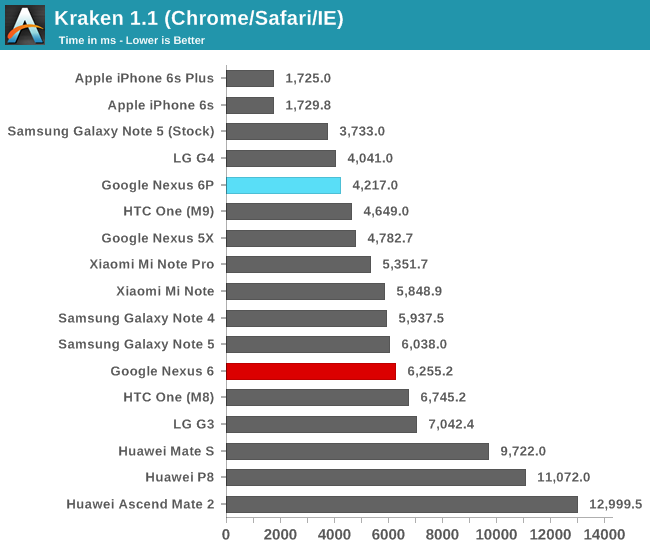
In Kraken the Nexus 6P is able to showcase a very good score that’s only beat by, oddly enough, the LG G4. As we’ve come to discover over the past year OEM browser libraries play a large role in device performance, even though we’re using the same Chrome build across different devices we see large differences in performance even within devices who employ the same SoC. It’s relatively unnerving to see this fragmentation in the ecosystem and in particular Chrome performing so differently across devices.
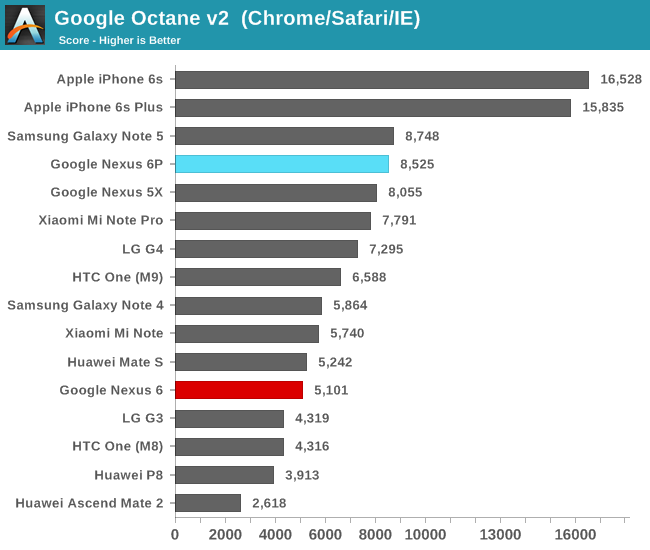
In Octane the Nexus 6P again performs very well, this time again beating our other devices such as the HTC One M9 or the Xiaomi Mi Note Pro. Among Android devices, only the Galaxy Note 5 - which on Octane is able to show equal performance as it does in its optimized stock browser - is able to beat it.
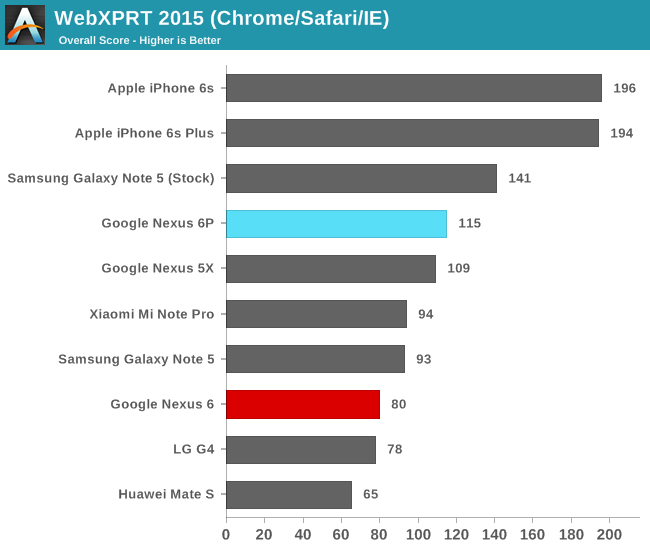
On WebXPRT again we see the 6P performs extremely well among Android devices, only being able to be beat by Samsung’s Exynos 7420 devices in the stock browser.
Continuing onto our system benchmarks, we start with Basemark OS II 2.0 from Basemark (formerly Rightware).

In the web test the Nexus 6P is yet again found at the high-end of the charts as it is able to provide good numbers. As we’ve seen in reviews such as on the Mate S it’s not necessarily raw performance that is demanded in these tests but also performance latency which plays a big role.
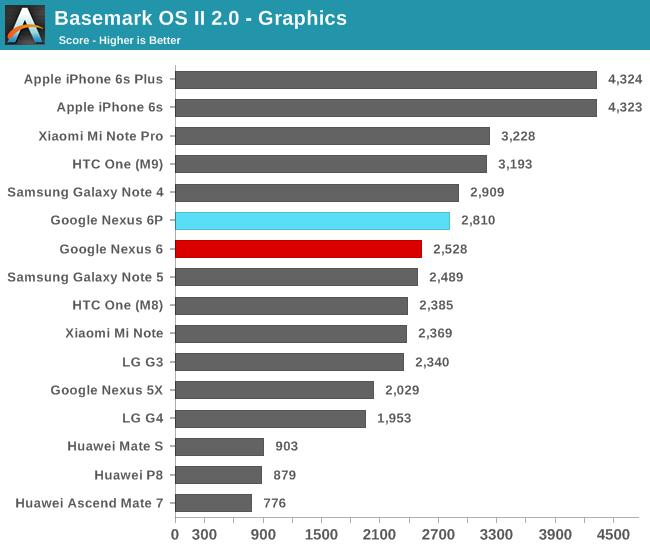
The graphics sub-test of Basemark has always been kind to the Adreno GPU so here again we see the Nexus 6P perform well, although not quite up to par with the other Snapdragon 810 devices we’ve tested in the past.
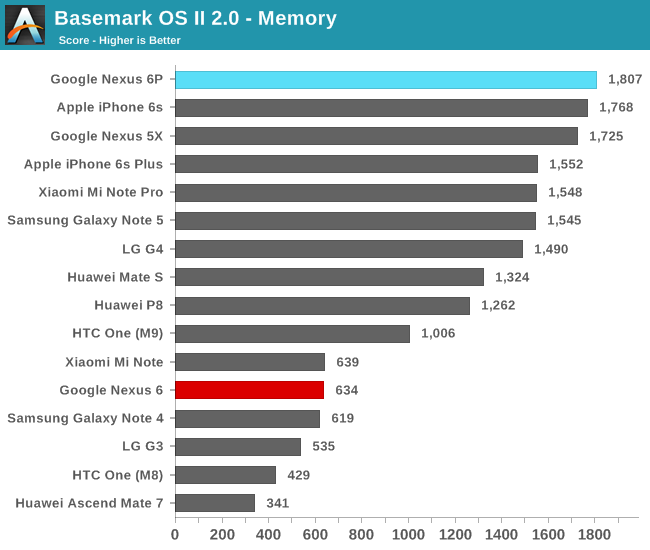
The Nexus 6P comes in a surprising first place on Basemark OS’s memory test. Again this is a mainly NAND-limited test but in contrast to our other synthetic test, performance and access patterns try to simulate more real-world applications.
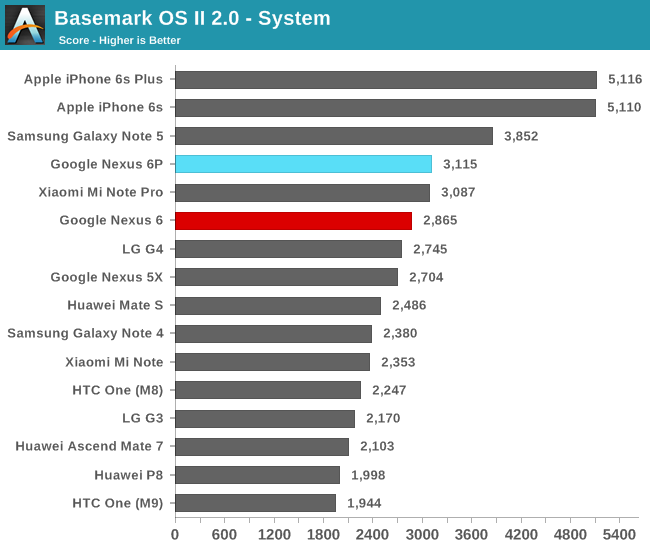
While the other tests try to test more realistic workloads, the system benchmark is all about measuring peak performance in a given set of scenarios. Here the Nexus 6P fares similarly to the Xiaomi Mi Note Pro but falls behind Exynos 7420 devices such as the Note 5.
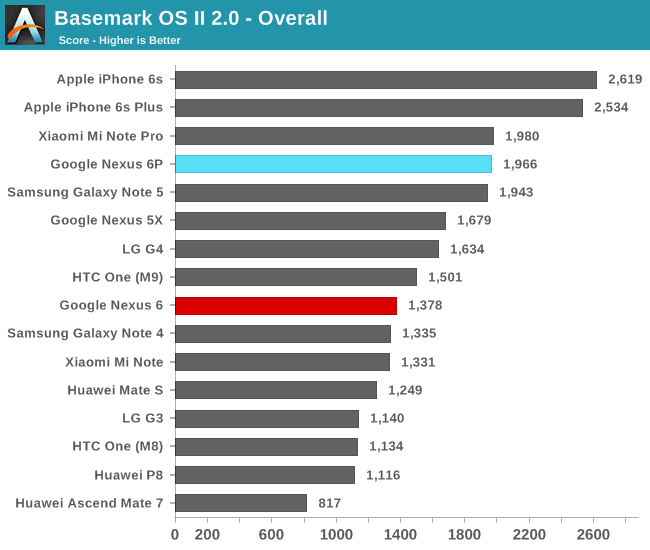
While I’m not a great fan of overall aggregate benchmark scores, we still see the Nexus 6P among the top of today’s currently available Android devices.
Moving on to PCMark from Futuremark, we’ll use a suite of tests that not only try to mimic real-world usage patterns, but actually make use of APIs that we currently find in use by many day-to-day applications.
Starting with the web browsing test we find the application use Android’s built-in WebView container which relies on OS-dependent components.
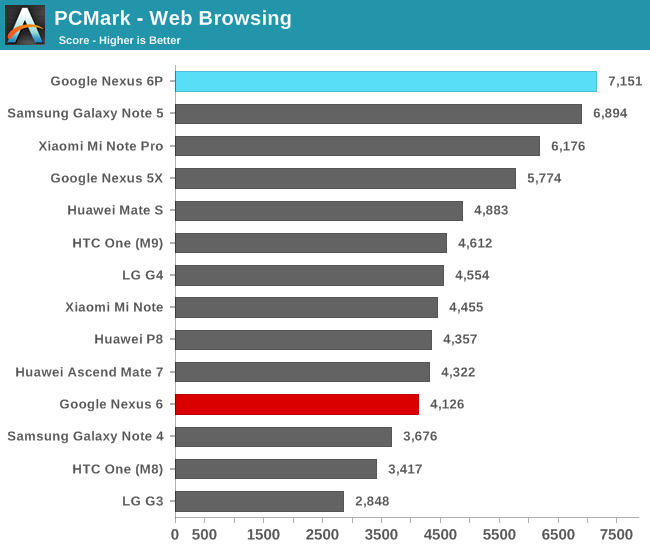
Here we see the Nexus 6P lead performance, slightly beating the Note 5. We’re also likely seeing advantages due to Android 6.0 as the Mi Note Pro, our other device with the Snapdragon 810 lags over a thousand points behind.

On the video playback score the Nexus 6P comes in towards the middle of the pack. The video test is a benchmark of both the video decoding hardware and software layers of the device, as well as the NAND speed, as fast seeking through the video is performed to test out how rapidly the device can resume playback.
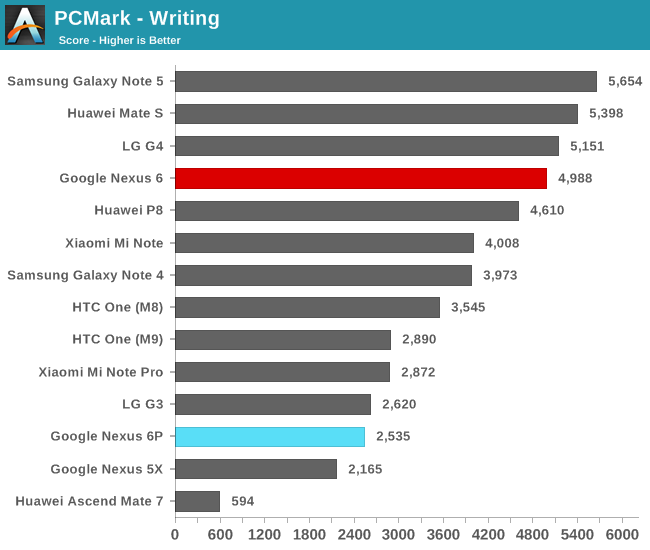
Now onto the writing test we come to one of the larger mysteries of the new Nexus 6’s performance. Both the Nexus 5X and the 6P seem to have large issues with PCMark’s writing test. The test itself consist of text manipulation and some file I/O, but most importantly it’s that this is purely a Java based test. Due to the way Android is architected, this means the code is handled and executed by the Android RunTime (ART). Futuremark have done a fantastic job in creating a test-case which is very sensitive to performance differences in the runtime.
At first when seeing these scores I thought that this was a side-effect of Android 6.0’s new big.LITTLE optimizations (which we’ll get back to in a later section), but even after turning those settings off the scores remained the same. After testing some other Java-based benchmarks I came to the conclusion that this has to be a software issue.
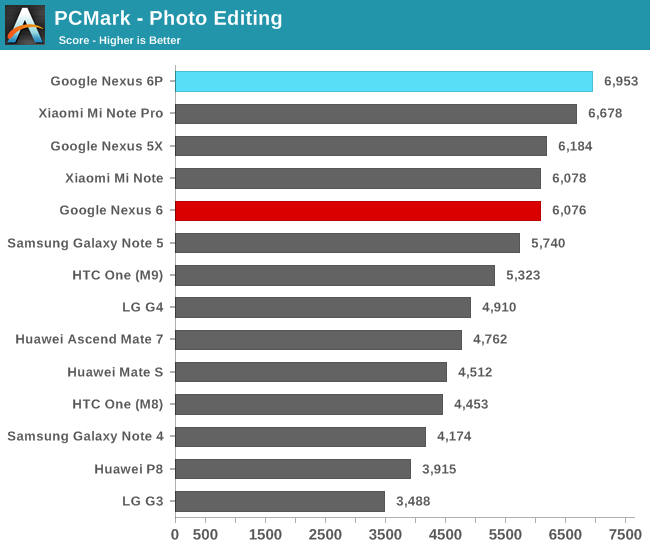
The photo editing uses RenderScript kernels to apply image processing on a set of pictures. With help of a powerful GPU the Nexus 6P performs top of the class
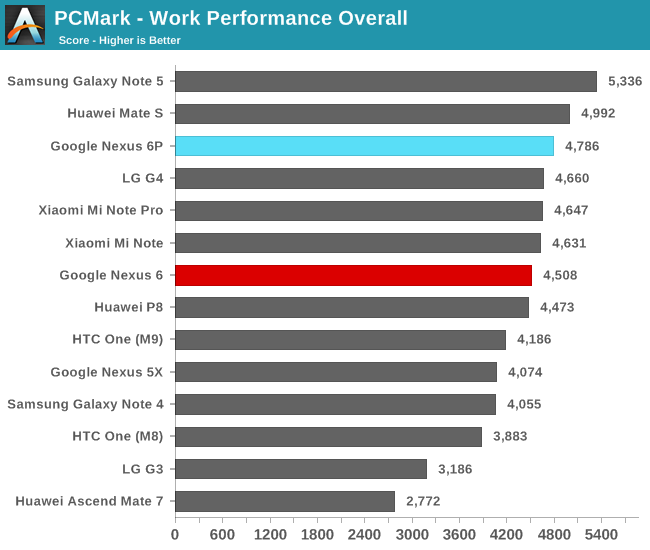
Due to the disappointing writing sub-score the Nexus 6P ends up third in the overall PCMark work performance score. Nevertheless, this is a good showing for the Snapdragon 810 device as it manages to slightly beat the Mi Note Pro and the HTC One M9.










219 Comments
View All Comments
hfm - Thursday, December 17, 2015 - link
Muscle memory is easily learned in short order. Took me a week or two switching from two years of an N5 to get used to the differences. I always ignore those parts of reviews unless it's an obvious exceptionally bad UX choice. These weren't.Nightfall983 - Wednesday, December 16, 2015 - link
I don't understand your need about stock Android not having brightness slider in the notification shade. Swipe the shade down with 2 fingers (or pull down twice), and is right there.hfm - Thursday, December 17, 2015 - link
Not to mention turning off adaptive brightness will get the phone to 500 nits. I leave it on though.. But for this review where numbers are thrown around it should have been done.ChronoReverse - Wednesday, December 16, 2015 - link
Hi Andrei, nice review. You may want to explore /system/etc/thermal-engine.conf to see how the software level thermal throttling is configured. It's pretty interesting how core shutdown and frequency limiting is configured with respect to the temperature. Interestingly enough, GPU throttling is tied to the main temperature sensor as well.You can even remove the file so that the phone relies solely on the fail-safe thermal throttling.
Jeff7181 - Wednesday, December 16, 2015 - link
Would have been nice to see the OnePlus phones in these benchmarks... especially battery life.GPz1100 - Wednesday, December 16, 2015 - link
How about the review including some details on phone call quality, signal reception, etc...?QinX - Wednesday, December 16, 2015 - link
Why? Who uses a phone to call someone and expect a clear reception these days?mystilleef - Wednesday, December 16, 2015 - link
I have both the Note 5 and the 6P and there is no way in hell I'd recommend the Note 5 over the 6P on any universe. The 6P has better battery life, better speakers (yes, contrary, to the reviewer, front facing speakers make a huge difference), better camera (especially low light indoor shots), better MEMORY MANAGEMENT, a better OS, and just a far better user experience.Anyone telling me TouchWiz is better than Stock Android is just delusional. I can't take that person seriously, and I don't think anyone should. TouchWiz has horrible, horrible, horrible memory management especially on the S6 and Note 5. If you enjoy your browser tabs and apps reloading every time you blink, or you fancy random crashes due to memory mismanagement, get the Note 5.
Yes, I own the Note 5, and used it exclusively before I got the 6P.
The ONLY thing great about the Note 5 are the camera and display. That's it. TouchWiz is a curse to Android so much so that there are rumors that Samsung is in talks with Google to help them fix, or optimize, TouchWiz.
I choked on my food when Andrei recommended the Note 5 over the 6p for non-US users. Are you serious, Andrei? Did you use the Note 5 for any extended period of time? The only way I can recommend the Note 5 is if you're willing to flash CM on it.
The Note 5 has been one of the most unstable and unreliable Android devices I've ever used. I regretted selling my Nexus 6 for it. I read all the hype here and on the Internet about the Note 5 and fell for it. As a matter of fact, I plan on getting a Nexus 6 as a backup device and using it instead of the Note 5. Heck even the Nexus 6 performs better than the Note 5, and no one can convince me that TouchWiz is not the culprit.
In what universe is TouchWiz a better user experience than stock Android? Slide down the notification drawer on your 6p and do the same on your Note 5, that's all you need to know about the user experience of either devices. And I'm not even going to talk about the stutter and lag that begins to creep in after a few days of using any TouchWiz device.
I enjoyed the review, but sheesh, it's hard for me to trust the taste or opinion of anyone recommending TouchWiz over stock Android. That, unfortunately, tainted the review for me. A review I'd have otherwise held in high regard.
VnnAmed - Wednesday, December 16, 2015 - link
And if you need to flash CM on Note 5 remember that you will trip KNOX. Or just staywith N6P and flash away since their warranty is not bootloader state dependent. @Andrei Frumusanu One thing that this review didn't mention is that Nexus devices are flash friendly. Why would I buy one of those if not for long-term support and ability to change ROMs? And I understand that these articles are for normal people, but are they now? I'm classified as a nerd by fellow humans and even I don't understand every aspect of this review. Especially the screen part gets me confused BTW but back to the point, you said that you don't like where the back button is. Well most ROMs will have an option to change that, heck even a ROM for my M7 has it. Buying a Nexus phone is entering into the world of customization especially because these phones are semi-development devices. So while this is a review I've been waiting for and it's actually more beefy than I expected (good, I like them beefy reviews) especially in the hardware department, it falls short when explaining why would one pick Nexus over some other device. And my answer to that is it's because of freedom to change most of the settings just by typing few lines of code. And even if like me someone is not very good at that there are thousands of devs that do it everyday and allow us puny humans to download their work for free. So in the end just a short comparison from the other side of the fence. I live in Europe too. And it's not the nice and rich western Europe either. I'm poor and poor tech enthusiasts can't allow themselves to throw money around. So if I am faced with a choice between S6 and N6P I will with certainty choose the latter. Why you may ask? Because I will happily use Android 8 or whatever while Samsung will say something like "you want new Android on S6? We're sorry, we can't pull miracles with these puny 3 gigs of RAM". And when S6 will be stuck on some buggy release of Android 7.1.2 I will be flashing Official Exodus ROM Android 9 for Angler. Because even if google falls short, devs rarely do, and that's the true power of a Nexus device. P.S. Remember N4? It has fully working AOSP marshmallow.phoenix_rizzen - Wednesday, December 16, 2015 - link
Just curious why you specify the wireless as being dual-band, when it's more than implied by the standards supported.802.11b and 802.11g are 2.4 GHz only. 802.11a and 802.11ac are 5 GHz only.
Thus, listing 802.11a/b/g/n/ac support means it's dual-band, 2.4 GHz and 5 GHz. It can't be anything else.
If it only supports 802.11n (or 802.11b/g/n), then it makes sense to specify whether it's 2.4 GHz only, or 2.4 GHz and 5 GHz, as n works in both bands.